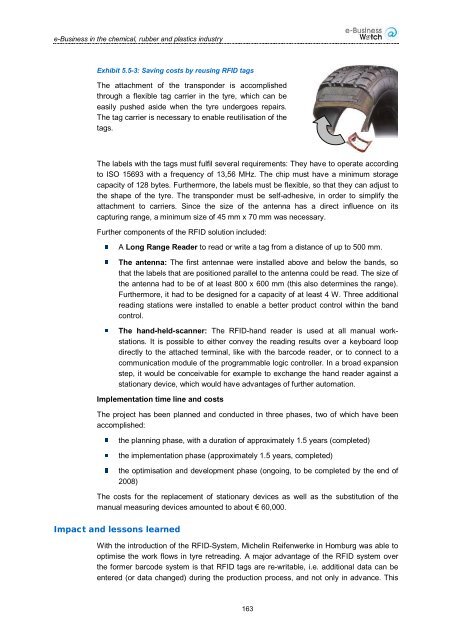Downloads - empirica
Downloads - empirica
Downloads - empirica
Create successful ePaper yourself
Turn your PDF publications into a flip-book with our unique Google optimized e-Paper software.
e-Business in the chemical, rubber and plastics industryExhibit 5.5-3: Saving costs by reusing RFID tagsThe attachment of the transponder is accomplishedthrough a flexible tag carrier in the tyre, which can beeasily pushed aside when the tyre undergoes repairs.The tag carrier is necessary to enable reutilisation of thetags.The labels with the tags must fulfil several requirements: They have to operate accordingto ISO 15693 with a frequency of 13,56 MHz. The chip must have a minimum storagecapacity of 128 bytes. Furthermore, the labels must be flexible, so that they can adjust tothe shape of the tyre. The transponder must be self-adhesive, in order to simplify theattachment to carriers. Since the size of the antenna has a direct influence on itscapturing range, a minimum size of 45 mm x 70 mm was necessary.Further components of the RFID solution included:A Long Range Reader to read or write a tag from a distance of up to 500 mm.The antenna: The first antennae were installed above and below the bands, sothat the labels that are positioned parallel to the antenna could be read. The size ofthe antenna had to be of at least 800 x 600 mm (this also determines the range).Furthermore, it had to be designed for a capacity of at least 4 W. Three additionalreading stations were installed to enable a better product control within the bandcontrol.The hand-held-scanner: The RFID-hand reader is used at all manual workstations.It is possible to either convey the reading results over a keyboard loopdirectly to the attached terminal, like with the barcode reader, or to connect to acommunication module of the programmable logic controller. In a broad expansionstep, it would be conceivable for example to exchange the hand reader against astationary device, which would have advantages of further automation.Implementation time line and costsThe project has been planned and conducted in three phases, two of which have beenaccomplished:the planning phase, with a duration of approximately 1.5 years (completed)the implementation phase (approximately 1.5 years, completed)the optimisation and development phase (ongoing, to be completed by the end of2008)The costs for the replacement of stationary devices as well as the substitution of themanual measuring devices amounted to about € 60,000.Impact and lessons learnedWith the introduction of the RFID-System, Michelin Reifenwerke in Homburg was able tooptimise the work flows in tyre retreading. A major advantage of the RFID system overthe former barcode system is that RFID tags are re-writable, i.e. additional data can beentered (or data changed) during the production process, and not only in advance. This163
















